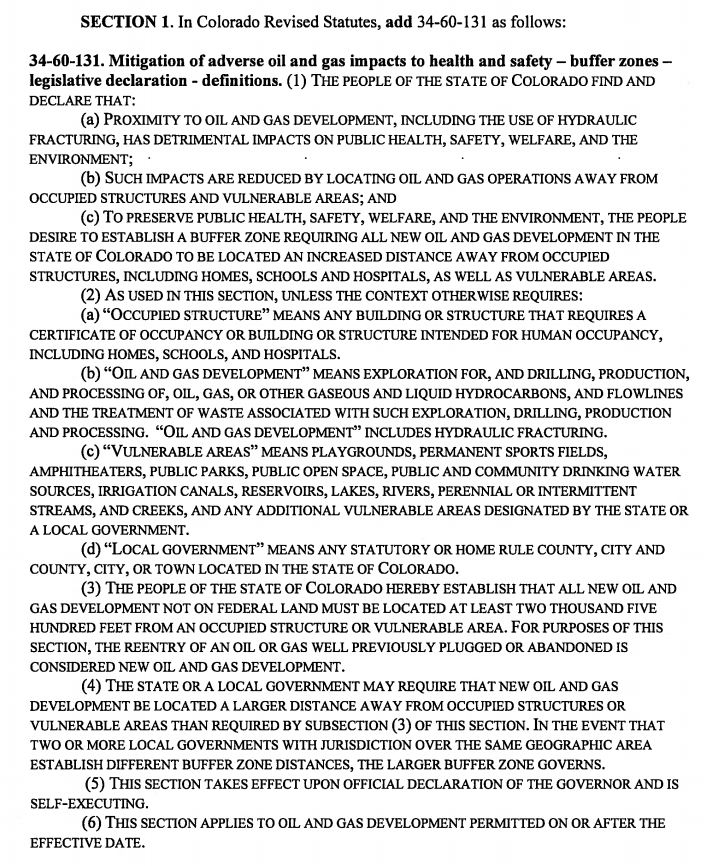2018 Colorado ballot initiative requiring 2,500-foot drilling setback, or higher, is in the state verification queue: 6 business days till verification deadline
Even though the Colorado Secretary of State hasn’t yet announced the signature verification count for initiative 97, which calls for a mandatory 2,500-foot setback for new oil and gas operations, advertising aimed at convincing voters not to vote for it aired on television and radio while the Denver Broncos were playing against the Washington Redskins in a pre-season game on Aug. 24.
On Aug. 27, a spokesperson for the Secretary of State’s office told Oil & Gas 360® that the verification of issue 97 “is not likely to be done this week, but that is not a certainty.” Either way, the Secretary of State’s deadline is just days away. The deadline is Sept. 5–next Wednesday.
What 97 would do
The proposal would alter state statute to push back any new drilling or other oil and gas operations by an extra 2,000 feet beyond the current 500-foot setback that is now common. If 97’s signed petitions succeed in resulting in a valid 98,492 voter signatures during the verification process, the measure (it is posted below) would be on the ballot in Colorado for all voters to consider in November.
Sounds like a reasonable idea: move oil and gas drilling farther from homes, schools and hospitals
Try this test: ask an average Colorado voter if he or she would be in favor of increasing the setback distance from schools, homes and hospitals to 2,500 feet, for new oil and gas drilling. On the surface it sounds like a reasonable idea—increase the health and safety of families, school children and sick people living in Colorado by moving oil and gas operations farther away. The voter we asked said, “yes.” She then asked, “Does that include fracking?” After confirming that it does, the person said she would definitely vote in favor of a larger setback. We said, “that would effectively shut down new drilling in most of the state.” Response: “Aren’t there enough oil and gas wells in Colorado already?”
What 97 would do to the oil and gas industry in Colorado
The result of voters passing 97 would be catastrophic to the oil and gas industry in Colorado, according to calculations by the Colorado Oil and Gas Conservation Commission (COGCC), the industry regulator in the state.
Initiative 97 would effectively stop most new drilling and development in the more densely populated areas of Colorado, including the Wattenberg field, by removing more than 90% of surface area from drilling and development.
The COGCC released acreage-reduction calculations based on a successful initiative 97, saying that of the 7.0 million acres of non-federal land in Colorado’s top oil and gas producing counties, proposed initiative #97 would exclude 6.5 million acres from drilling and development. That’s a 93% reduction in non-federal land available to drill.
97 also gives local governments the right to impose bigger setbacks: de facto removal of state’s jurisdiction over oil and gas
The number of excluded acres could go higher as the revised statute would also allow local municipalities to impose their own larger setbacks in order to remove areas within their jurisdiction from drilling.
That is very different today, as Colorado law places all permitting decisions with the COGCC. But 97 would allow local municipalities to change that.

97: making its way up the ladder
According to the Colorado Secretary of State’s office, as of the afternoon of Aug. 27, four initiatives are still under review. They are:
- Initiative 108, just compensation for reduction in fair market value by government law or regulation,
- Initiative 126, payday loans,
- Initiative 97, setback requirement for oil and gas development, and
- Initiative 173, campaign contributions.
The results of the review for all of them must be announced by Sept. 5. The Secretary of State’s office told Oil & Gas 360® that ballot initiative voter signatures are verified in the order received. Signatures for 97 were among the final groups turned in on Aug. 6.
Macquarie Research reported in an equity research note on Aug. 6 that proponents of initiative 97 had turned in enough signatures, in the firm’s estimation, for the measure to make it to the November ballot. “We believe the Initiative is likely to make the November ballot,” Macquarie said in its note. “This is a large negative for Colorado names and one that creates a meaningful overhang until November.”
“The supporters are indicating they have turned in over 170,000+,” Macquarie said in the note. “The quick take away is we believe that Initiative 97 WILL likely pass the verification process based on the number of signatures submitted.”
Macquarie said it believes “that 130,000-150,000+ signatures are required to meet the threshold of 98,492 verified signatures. We rely upon the Secretary of State’s initial estimate for our initial conclusion. Admittedly, there is some uncertainty in the number but we believe the market has not believed in this outcome and stocks will react negatively until proven otherwise.”
The verification process
In a press release issued Aug. 23, entitled “Second transportation measure makes the ballot,” the Secretary of State said of all the proposed initiatives, “Today’s deadline was to turn in 98,492 valid voter signatures, which is 5 percent of the total votes cast for all candidates for Secretary of State in the 2014 general election. A random sample of signatures is then conducted.”
Using initiative 153 as an example, here’s the math
“Backers of Initiative 153 submitted their petitions on Aug. 6. A 5-percent random sample of the submitted signatures projected the number of valid signatures to be greater than 110 percent of the total number of signatures required for placement on the ballot,” the Secretary of State said.
Petition verification summary for No. 153:
| Total number of qualified signatures submitted | 195,499 |
| 5% of qualified signatures submitted (random sample) | 9,775 |
| Total number of entries accepted (valid) from the random sample | 5,913 |
| Total number of entries rejected (invalid) from the random sample | 3,862 |
| Number of projected valid signatures from the random sample | 118,259 |
| Total number of signatures required for placement on the ballot | 98,492 |
| Projected percentage of required valid signatures | 120.07% |







